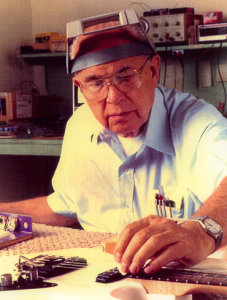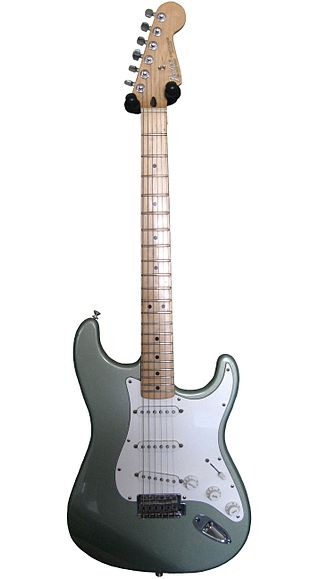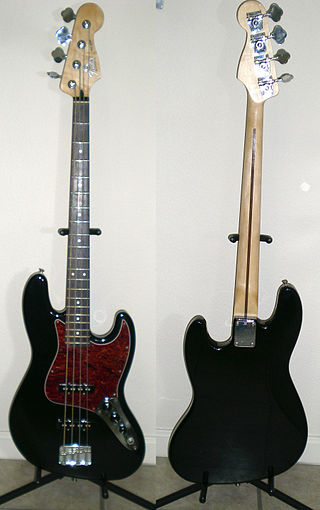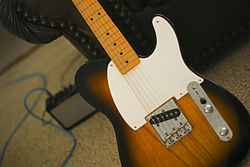
Clarence Leonidas Fender was an American inventor and founder of the Fender Musical Instruments Corporation.

The Fender Stratocaster, colloquially known as the Strat, is a model of electric guitar designed between 1952 and 1954 by Leo Fender, Bill Carson, George Fullerton, and Freddie Tavares. The Fender Musical Instruments Corporation has continuously manufactured the Stratocaster since 1954. It is a double-cutaway guitar, with an extended top "horn" shape for balance. Along with the Gibson Les Paul, Gibson SG, and Fender Telecaster, it is one of the most-often emulated electric guitar shapes. "Stratocaster" and "Strat" are trademark terms belonging to Fender. Guitars that duplicate the Stratocaster by other manufacturers are sometimes called S-Type or ST-type guitars.

A single coil pickup is a type of magnetic transducer, or pickup, for the electric guitar and the electric bass. It electromagnetically converts the vibration of the strings to an electric signal. Single coil pickups are one of the two most popular designs, along with dual-coil or "humbucking" pickups.

The Fender Musical Instruments Corporation is an American manufacturer and marketer of musical instruments and amplifiers. Fender produces acoustic guitars, bass amplifiers and public address equipment; however, it is best known for its solid-body electric guitars and bass guitars, particularly the Stratocaster, Telecaster, Jaguar, Jazzmaster, Precision Bass, and the Jazz Bass. The company was founded in Fullerton, California, by Clarence Leonidas "Leo" Fender in 1946. Andy Mooney has served as the chief executive officer (CEO) since June 2015.
The Fender Jaguar is an electric guitar by Fender Musical Instruments characterized by an offset-waist body, a relatively unusual switching system with two separate circuits for lead and rhythm, and a short-scale 24" neck. Owing some roots to the Jazzmaster, it was introduced in 1962 as Fender's feature-laden top-of-the-line model, designed to lure players from Gibson. During its initial 13-year production run, the Jaguar did not sell as well as the less expensive Stratocaster and Telecaster, and achieved its most noticeable popularity in the surf music scene. After the Jaguar was taken out of production in 1975, vintage Jaguars became popular first with American punk rock players, and then more so during the alternative rock, shoegazing and indie rock movements of the 1980s and 1990s. Fender began making a version in Japan in the mid-1980s, and then introduced a USA-made reissue in 1999. Since then, Fender has made a variety of Jaguars in America, Mexico, Indonesia and China under both the Fender and Squier labels. Original vintage Jaguars sell for many times their original price.

The Fender Precision Bass is a model of electric bass guitar manufactured by Fender Musical Instruments Corporation. In its standard, post-1957 configuration, the Precision Bass is a solid body, four-stringed instrument usually equipped with a single split-coil humbucking pickup and a one-piece, 20-fret maple neck with rosewood or maple fingerboard.

The Fender Jazz Bass is the second model of electric bass created by Leo Fender. It is distinct from the Precision Bass in that its tone is brighter and richer in the midrange and treble with less emphasis on the fundamental frequency. The body shape is also different from the Precision Bass, in that the Precision Bass has a symmetrical lower bout on the body, designed after the Telecaster and Stratocaster lines of guitars, while the Jazz Bass has an offset lower bout, mimicking the design aesthetic of the Jaguar and Jazzmaster guitars.
The Fender Lead Series was produced by the Fender/Rogers/Rhodes Division of CBS Musical Instruments. The series comprised Lead I, Lead II, Lead III and Lead Bass models.

The Squier '51 is an electric guitar made by Squier, a subsidiary of Fender. The '51 is notable for being one of the few original designs made by Squier, which normally manufactures less expensive authorized copies of Fender's popular guitars and bass guitars.

The Fender Jaguar Bass is an electric bass guitar currently manufactured in Mexico by the Fender Musical Instruments Corporation.
The Fender Telecaster Thinline is a semi-hollow guitar made by the Fender company. It is a Telecaster with body cavities. Designed by German luthier Roger Rossmeisl in 1968, it was introduced in 1969 and updated in 1972 by replacing the standard Telecaster pickups with a pair of Fender Wide Range humbucking pickups, bullet truss-rod and 3-bolt neck.
The Fender Telecaster Bass is an electric bass introduced in 1968 by Fender Musical Instruments Corporation. With few physical changes through the 1970s, it was discontinued in 1979 and reissued in 2007 by Fender's subsidiary Squier as the Squier Vintage Modified Precision Bass TB, which was discontinued in 2014.

Fender Contemporary Stratocaster electric guitars were produced by Fender Japan in the 1980s.
The Fender Bullet was an electric guitar originally designed by John Page and manufactured and marketed by the Fender Musical Instruments Corporation. It was first introduced as a line of "student" guitars to replace the outgoing Mustang and Musicmaster models.
Electric guitar design is a type of industrial design where the looks and efficiency of the shape as well as the acoustical aspects of the guitar are important factors. In the past many guitars have been designed with various odd shapes as well as very practical and convenient solutions to improve the usability of the object.
The James Burton Telecaster is a Signature/Artist Series electric guitar made by Fender Musical Instruments Corporation. The guitar is available in two models, Upgrade and Standard, and both were designed by American country-rock guitarist James Burton along with Dan Smith at Fender. Both models are patterned after mid-century Fender Telecaster guitars played by Burton during his long career with Ricky Nelson, Elvis Presley, Merle Haggard, Emmylou Harris, John Denver and many other well-known artists.
The Fender Telecaster, colloquially known as the Tele, is an electric guitar produced by Fender. Together with its sister model the Esquire, it was the world's first mass-produced, commercially successful solid-body electric guitar. Its simple yet effective design and revolutionary sound broke ground and set trends in electric guitar manufacturing and popular music.
Blade Guitars is a manufacturer of electric guitars and bass guitars founded by luthier Gary Levinson in 1987. Levinson had been repairing guitars since 1964 and, in 1977, during his graduate studies at the University of Basel, Switzerland, he founded Guitars by Levinson. Using the experience he gathered from his work, he decided to start Blade Guitars in 1985. By 1986, he was refining the idea of a line of guitars based on the concept he defines as "Classic Design, Creative Technology"; at this time, he was also determining the features that would characterize his range of guitars. In January 1987, a manufacturing deal was reached for the production of the guitars. Blade Guitars made their debut in October 1987, at the music show of Tokyo. Their presentation at the Frankfurt Musikmesse in 1988 signalled their European launch.

The Fender Cabronita Telecaster is a class of guitars built by Fender Musical Instruments Corporation based on their Telecaster body shape. The name Cabronita is Spanish slang and roughly translates as little bastard or little devil. While retaining the shape and general feel of a Telecaster, they are a radical departure from the traditional electronics and sounds associated with the instrument. Like virtually all Telecaster submodels, they are labeled simply as a Fender Telecaster on the headstock logo, identifiable only by their features.














